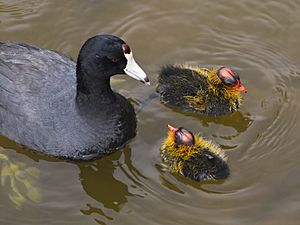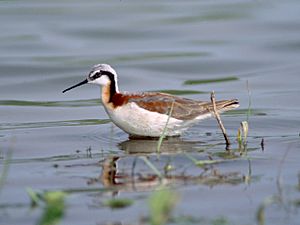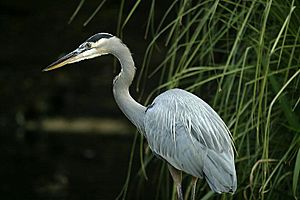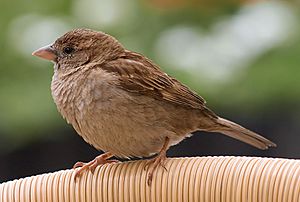List of birds of South Dakota facts for kids
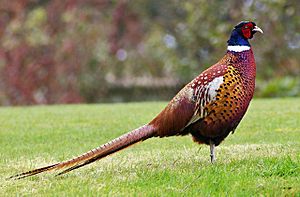
This page lists the different types of birds found in South Dakota, a state in the United States. The South Dakota Ornithologists' Union (SDOU) keeps track of these birds. As of October 2021, there were 440 different bird species on their official list.
Some birds are marked with special tags:
- A means Accidental: This bird has only been seen 0-2 times in the last 10 years. It's very rare!
- C means Casual: This bird has been seen 4-6 times in the last 10 years. It's still rare, but a bit more common than "accidental" birds.
- I means Introduced: These birds were brought to North America by people, not by nature.
This list follows a special order set by the American Ornithological Society (AOS). The common names and scientific names (like Dendrocygna autumnalis) are also from their list.
Contents
- Ducks, Geese, and Waterfowl
- Pheasants, Grouse, and Allies
- Grebes
- Pigeons and Doves
- Nightjars and Allies
- Hummingbirds
- Rails, Gallinules, and Coots
- Cranes
- Stilts and Avocets
- Plovers and Lapwings
- Sandpipers and Allies
- Gulls, Terns, and Skimmers
- Loons
- Pelicans
- Herons, Egrets, and Bitterns
- Hawks, Eagles, and Kites
- Owls
- Woodpeckers
- Falcons and Caracaras
- Crows, Jays, and Magpies
- Swallows
- Waxwings
- Nuthatches
- Wrens
- Mockingbirds and Thrashers
- Old World Sparrows
- Finches and Allies
- New World Sparrows
- Troupials and Allies
- New World Warblers
- Cardinals and Allies
- See also
Ducks, Geese, and Waterfowl
Order: Anseriformes Family: Anatidae
This family includes ducks, geese, and swans. These birds are great at living in water. They have webbed feet, flat bills, and feathers that shed water easily because of special oils. Forty-one different kinds of these birds have been seen in South Dakota.
- Black-bellied whistling-duck, Dendrocygna autumnalis (A)
- Fulvous whistling-duck, Dendrocygna bicolor (A)
- Snow goose, Anser caerulescens
- Ross's goose, Anser rossii
- Greater white-fronted goose, Anser albifrons
- Brant, Branta bernicla (A)
- Cackling goose, Branta hutchinsii
- Canada goose, Branta canadensis
- Mute swan, Cygnus olor (A) (I)
- Trumpeter swan, Cygnus buccinator
- Tundra swan, Cygnus columbianus
- Wood duck, Aix sponsa
- Blue-winged teal, Spatula discors
- Cinnamon teal, Spatula cyanoptera
- Northern shoveler, Spatula clypeata
- Gadwall, Mareca strepera
- Eurasian wigeon, Mareca penelope (A)
- American wigeon, Mareca americana
- Mallard, Anas platyrhynchos
- American black duck, Anas rubripes
- Mottled duck, Anas fulvigula (A)
- Northern pintail, Anas acuta
- Green-winged teal, Anas crecca
- Canvasback, Aythya valisineria
- Redhead, Aythya americana
- Ring-necked duck, Aythya collaris
- Greater scaup, Aythya marila
- Lesser scaup, Aythya affinis
- Common eider, Somateria mollissima (A)
- Harlequin duck, Histrionicus histrionicus (C)
- Surf scoter, Melanitta perspicillata
- White-winged scoter, Melanitta deglandi
- Black scoter, Melanitta americana
- Long-tailed duck, Clangula hyemalis
- Bufflehead, Bucephala albeola
- Common goldeneye, Bucephala clangula
- Barrow's goldeneye, Bucephala islandica
- Hooded merganser, Lophodytes cucullatus
- Common merganser, Mergus merganser
- Red-breasted merganser, Mergus serrator
- Ruddy duck, Oxyura jamaicensis
Pheasants, Grouse, and Allies
Order: Galliformes Family: Phasianidae
This group includes pheasants and their relatives. These birds live on land and vary in size. They are usually plump with wide, short wings. Many are hunted for sport or raised for food. Seven species have been recorded in South Dakota.
- Wild turkey, Meleagris gallopavo
- Ruffed grouse, Bonasa umbellus
- Greater sage-grouse, Centrocercus urophasianus
- Sharp-tailed grouse, Tympanuchus phasianellus
- Greater prairie-chicken, Tympanuchus cupido
- Gray partridge, Perdix perdix (I)
- Ring-necked pheasant, Phasianus colchicus (I)
Grebes
Order: Podicipediformes Family: Podicipedidae
Grebes are small to medium-sized birds that dive in freshwater. They have special lobed toes, which make them excellent swimmers and divers. However, their feet are set far back on their bodies, so they are clumsy on land. Six species have been seen in South Dakota.
- Pied-billed grebe, Podilymbus podiceps
- Horned grebe, Podiceps auritus
- Red-necked grebe, Podiceps grisegena
- Eared grebe, Podiceps nigricollis
- Western grebe, Aechmorphorus occidentalis
- Clark's grebe, Aechmorphorus clarkii
Pigeons and Doves
Order: Columbiformes Family: Columbidae
Pigeons and doves are birds with sturdy bodies, short necks, and thin bills. Seven species have been recorded in South Dakota.
- Rock pigeon, Columba livia (I)
- Band-tailed pigeon, Patagioenas fasciata (A)
- Eurasian collared-dove, Streptopelia decaocto (I)
- Inca dove, Columbina inca (A)
- Common ground dove, Columbina passerina (A)
- White-winged dove, Zenaida asiatica (C)
- Mourning dove, Zenaida macroura
Nightjars and Allies
Order: Caprimulgiformes Family: Caprimulgidae
Nightjars are medium-sized birds that are active at night. They usually build their nests on the ground. They have long wings, short legs, and very short bills. Their soft feathers are colored to blend in with bark or leaves. Four species have been seen in South Dakota.
- Common nighthawk, Chordeiles minor
- Common poorwill, Phalaenoptilus nuttallii
- Chuck-will's-widow, Antrostomus carolinensis
- Eastern whip-poor-will, Antrostomus vociferus
Hummingbirds
Order: Apodiformes Family: Trochilidae
Hummingbirds are tiny birds famous for hovering in the air. They flap their wings incredibly fast. They are the only birds that can fly backward! Eight species have been recorded in South Dakota.
- Rivoli's hummingbird, Eugenes fulgens (A)
- Ruby-throated hummingbird, Archilochus colubris
- Black-chinned hummingbird, Archilochus alexandri (A)
- Anna's hummingbird, Calypte anna (A)
- Costa's hummingbird, Calypte costae (A)
- Calliope hummingbird, Selasphorus calliope
- Rufous hummingbird, Selasphorus rufus
- Broad-tailed hummingbird, Selasphorus platycercus
Rails, Gallinules, and Coots
Order: Gruiformes Family: Rallidae
This is a large family of small to medium-sized birds. They include rails, crakes, coots, and gallinules. Most of these birds live in thick plants near lakes, swamps, or rivers. They are often shy and hard to spot. Seven species have been seen in South Dakota.
- King rail, Rallus elegans (A)
- Virginia rail, Rallus limicola
- Sora, Porzana carolina
- Common gallinule, Gallinula galeata
- American coot, Fulica americana
- Purple gallinule, Porphyrio martinicus (A)
- Yellow rail, Coturnicops noveboracensis (A)
Cranes

Order: Gruiformes Family: Gruidae
Cranes are large birds with long legs and long necks. Unlike herons, which look similar, cranes fly with their necks stretched out. They often have loud and fancy "dances" to attract mates. Two species have been recorded in South Dakota.
- Sandhill crane, Antigone canadensis
- Whooping crane, Grus americana
Stilts and Avocets
Order: Charadriiformes Family: Recurvirostridae
This family includes avocets and stilts. They are large wading birds. Avocets have long legs and bills that curve upwards. Stilts have extremely long legs and long, thin, straight bills. Two species have been seen in South Dakota.
- Black-necked stilt, Himantopus mexicanus
- American avocet, Recurvirostra americana
Plovers and Lapwings
Order: Charadriiformes Family: Charadriidae
This family includes plovers, dotterels, and lapwings. They are small to medium-sized birds with compact bodies and short, thick necks. They live in open areas worldwide, often near water. Eight species have been recorded in South Dakota.
- Black-bellied plover, Pluvialis squatarola
- American golden-plover, Pluvialis dominica
- Killdeer, Charadrius vociferus
- Semipalmated plover, Charadrius semipalmatus
- Piping plover, Charadrius melodus
- Wilson's plover, Charadrius wilsonia (A)
- Snowy plover, Charadrius nivosus (C)
- Mountain plover, Charadrius montanus (A)
Sandpipers and Allies
Order: Charadriiformes Family: Scolopacidae
This is a large and varied family of small to medium-sized shorebirds. It includes sandpipers, curlews, godwits, and snipes. Most of these birds eat small bugs they find in mud or soil. Thirty-two species have been recorded in South Dakota.
- Upland sandpiper, Bartramia longicauda
- Whimbrel, Numenius phaeopus
- Long-billed curlew, Numenius americanus
- Hudsonian godwit, Limosa haemastica
- Marbled godwit, Limosa fedoa
- Ruddy turnstone, Arenaria interpres
- Red knot, Calidris canutus
- Ruff, Calidris pugnax (C)
- Stilt sandpiper, Calidris himantopus
- Curlew sandpiper, Calidris ferruginea (A)
- Sanderling, Calidris alba
- Dunlin, Calidris alpina
- Purple sandpiper, Calidris maritima (H)
- Baird's sandpiper, Calidris bairdii
- Least sandpiper, Calidris minutilla
- White-rumped sandpiper, Calidris fuscicollis
- Buff-breasted sandpiper, Calidris subruficollis
- Pectoral sandpiper, Calidris melanotos
- Semipalmated sandpiper, Calidris pusilla
- Western sandpiper, Calidris mauri (C)
- Short-billed dowitcher, Limnodromus griseus
- Long-billed dowitcher, Limnodromus scolopaceus
- American woodcock, Scolopax minor
- Wilson's snipe, Gallinago delicata
- Spotted sandpiper, Actitis macularius
- Solitary sandpiper, Tringa solitaria
- Lesser yellowlegs, Tringa flavipes
- Willet, Tringa semipalmata
- Greater yellowlegs, Tringa melanoleuca
- Wilson's phalarope, Phalaropus tricolor
- Red-necked phalarope, Phalaropus lobatus
- Red phalarope, Phalaropus fulicarius (A)
Gulls, Terns, and Skimmers
Order: Charadriiformes Family: Laridae
This family includes gulls, terns, and skimmers. They are usually gray or white, often with black marks on their heads or wings. They have strong, longish bills and webbed feet. Twenty-four species have been recorded in South Dakota.
- Black-legged kittiwake, Rissa tridactyla
- Ivory gull, Pagophila eburnea (A)
- Sabine's gull, Xema sabini
- Bonaparte's gull, Chroicocephalus philadelphia
- Little gull, Hydrocoleus minutus
- Ross's gull, Rhodostethia rosea
- Laughing gull, Leucophaeus atricilla (C)
- Franklin's gull, Leucophaeus pipixcan
- Short-billed gull, Larus brachyrhynchus (C)
- Ring-billed gull, Larus delawarensis
- California gull, Larus californicus
- Herring gull, Larus argentatus
- Iceland gull, Larus glaucoides
- Lesser black-backed gull, Larus fuscus
- Glaucous-winged gull, Larus glaucescens (C)
- Glaucous gull, Larus hyperboreus
- Great black-backed gull, Larus marinus
- Least tern, Sternula antillarum
- Gull-billed tern, Gelochelidon nilotica (A)
- Caspian tern, Hydroprogne caspia
- Black tern, Chlidonias niger
- Common tern, Sterna hirundo
- Arctic tern, Sterna paradisaea (A)
- Forster's tern, Sterna forsteri
Loons
Order: Gaviiformes Family: Gaviidae
Loons are water birds about the size of a large duck. They are mostly gray or black and have bills shaped like spears. Loons swim very well and can fly, but they are almost helpless on land because their legs are at the very back of their bodies. Four species have been recorded in South Dakota.
- Red-throated loon, Gavia stellata (C)
- Pacific loon, Gavia pacifica
- Common loon, Gavia immer
- Yellow-billed loon, Gavia adamsii (A)
Pelicans
Order: Pelecaniformes Family: Pelecanidae
Pelicans are very large water birds. They have a special pouch under their beak for catching fish. Like other birds in their group, they have four webbed toes. Two species have been recorded in South Dakota.
- American white pelican, Pelecanus erythrorhynchos
- Brown pelican, Pelecanus occidentalis (A)
Herons, Egrets, and Bitterns
Order: Pelecaniformes Family: Ardeidae
This family includes herons, egrets, and bitterns. Herons and egrets are medium to large wading birds with long necks and legs. Bitterns are usually shorter-necked and more secretive. These birds fly with their necks pulled back. Eleven species have been recorded in South Dakota.
- American bittern, Botaurus lentiginosus
- Least bittern, Ixobrychus exilis
- Great blue heron, Ardea herodias
- Great egret, Ardea alba
- Snowy egret, Egretta thula
- Little blue heron, Egretta caerulea
- Tricolored heron, Egretta tricolor
- Cattle egret, Bubulcus ibis
- Green heron, Butorides virescens
- Black-crowned night-heron, Nycticorax nycticorax
- Yellow-crowned night-heron, Nyctanassa violacea
Hawks, Eagles, and Kites
Order: Accipitriformes Family: Accipitridae
This family includes birds of prey like hawks, eagles, and kites. These birds have very large, strong, hooked beaks for tearing meat from their prey. They also have powerful legs, sharp talons, and excellent eyesight. Fifteen species have been recorded in South Dakota.
- White-tailed kite, Elanus leucurus (A)
- Swallow-tailed kite, Elanoides forficatus (A)
- Golden eagle, Aquila chrysaetos
- Northern harrier, Circus hudsonius
- Sharp-shinned hawk, Accipiter striatus
- Cooper's hawk, Accipiter cooperii
- American goshawk, Accipiter atricapillus
- Bald eagle, Haliaeetus leucocephalus
- Mississippi kite, Ictinia mississippiensis (C)
- Red-shouldered hawk, Buteo lineatus (C)
- Broad-winged hawk, Buteo platypterus
- Swainson's hawk, Buteo swainsoni
- Red-tailed hawk, Buteo jamaicensis
- Rough-legged hawk, Buteo lagopus
- Ferruginous hawk, Buteo regalis
Owls
Order: Strigiformes Family: Strigidae
Typical owls are usually solitary birds of prey that are active at night. They have large eyes that face forward and ears that help them hear well. They have a beak like a hawk and a noticeable circle of feathers around each eye. Twelve species have been recorded in South Dakota.
- Flammulated owl, Psiloscops flammeolus (A)
- Eastern screech-owl, Megascops asio
- Great horned owl, Bubo virginianus
- Snowy owl, Bubo scandiacus
- Northern hawk owl, Surnia ulula (A)
- Burrowing owl, Athene cunicularia
- Barred owl, Strix varia
- Great gray owl, Strix nebulosa (A)
- Long-eared owl, Asio otus
- Short-eared owl, Asio flammeus
- Boreal owl, Aegolius funereus (A)
- Northern saw-whet owl, Aegolius acadicus
Woodpeckers
Order: Piciformes Family: Picidae
Woodpeckers are small to medium-sized birds. They have beaks like chisels, short legs, stiff tails, and long tongues for catching insects. Many woodpeckers tap loudly on tree trunks with their beaks. Twelve species have been recorded in South Dakota.
- Lewis's woodpecker, Melanerpes lewis
- Red-headed woodpecker, Melanerpes erythrocephalus
- Red-bellied woodpecker, Melanerpes carolinus
- Williamson's sapsucker, Sphyrapicus thyroideus (A)
- Yellow-bellied sapsucker, Sphyrapicus varius
- Red-naped sapsucker, Sphyrapicus nuchalis
- American three-toed woodpecker, Picoides dorsalis
- Black-backed woodpecker, Picoides arcticus
- Downy woodpecker, Dryobates pubescens
- Hairy woodpecker, Dryobates villosus
- Northern flicker, Colaptes auratus
- Pileated woodpecker, Dryocopus pileatus
Falcons and Caracaras
Order: Falconiformes Family: Falconidae
This family includes falcons and caracaras. They are birds of prey that are active during the day. They are different from hawks and eagles because they kill their prey with their beaks, not their talons (claws). Six species have been recorded in South Dakota.
- Crested caracara, Caracara plancus (A)
- American kestrel, Falco sparverius
- Merlin, Falco columbarius
- Gyrfalcon, Falco rusticolus
- Peregrine falcon, Falco peregrinus
- Prairie falcon, Falco mexicanus
Crows, Jays, and Magpies
Order: Passeriformes Family: Corvidae
This family includes crows, ravens, jays, and magpies. These birds are larger than average for songbirds. Some of the bigger species are very intelligent. Eight species have been recorded in South Dakota.
- Canada jay, Perisoreus canadensis
- Pinyon jay, Gymnorhinus cyanocephalus
- Steller's jay, Cyanocitta stelleri (A)
- Blue jay, Cyanocitta cristata
- Clark's nutcracker, Nucifraga columbiana
- Black-billed magpie, Pica hudsonia
- American crow, Corvus brachyrhynchos
- Common raven, Corvus corax (C)
Swallows
Order: Passeriformes Family: Hirundinidae
Swallows are birds that are built for catching food while flying. They have slender bodies, long pointed wings, and a short bill with a wide mouth. Their feet are better for perching than walking. Seven species have been recorded in South Dakota.
- Bank swallow, Riparia riparia
- Tree swallow, Tachycineta bicolor
- Violet-green swallow, Tachycineta thalassina
- Northern rough-winged swallow, Stelgidopteryx serripennis
- Purple martin, Progne subis
- Barn swallow, Hirundo rustica
- Cliff swallow, Petrochelidon pyrrhonota
Waxwings
Order: Passeriformes Family: Bombycillidae
Waxwings are a group of songbirds with soft, silky feathers. They have unique red tips on some of their wing feathers that look like sealing wax. These birds live in northern forests. They eat insects in summer and berries in winter. Two species have been recorded in South Dakota.
- Bohemian waxwing, Bombycilla garrulus
- Cedar waxwing, Bombycilla cedrorum
Nuthatches
Order: Passeriformes Family: Sittidae
Nuthatches are small woodland birds. They have a special ability to climb down trees headfirst, which most other birds cannot do. Nuthatches have large heads, short tails, and strong bills and feet. Three species have been recorded in South Dakota.
- Red-breasted nuthatch, Sitta canadensis
- White-breasted nuthatch, Sitta carolinensis
- Pygmy nuthatch, Sitta pygmaea
Wrens
Order: Passeriformes Family: Troglodytidae
Wrens are small birds that are hard to see, but they have very loud songs. They have short wings and thin, downward-curved bills. Many species often hold their tails straight up. All wrens eat insects. Nine species have been recorded in South Dakota.
- Rock wren, Salpinctes obsoletus
- Canyon wren, Catherpes mexicanus
- House wren, Troglodytes aedon
- Pacific wren, Troglodytes pacificus (C)
- Winter wren, Troglodytes hiemalis
- Sedge wren, Cistothorus platensis
- Marsh wren, Cistothorus palustris
- Carolina wren, Thryothorus ludovicianus
- Bewick's wren, Thryomanes bewickii (A)
Mockingbirds and Thrashers
Order: Passeriformes Family: Mimidae
This family includes thrashers, mockingbirds, and catbirds. These birds are known for their amazing songs and their ability to copy many different bird calls and other sounds. They are usually dull gray and brown in color. Five species have been recorded in South Dakota.
- Gray catbird, Dumetella carolinensis
- Curve-billed thrasher, Toxostoma curvirostre (A)
- Brown thrasher, Toxostoma rufum
- Sage thrasher, Oreoscoptes montanus
- Northern mockingbird, Mimus polyglottos
Old World Sparrows
Order: Passeriformes Family: Passeridae
Old World sparrows are small songbirds. They are generally plump, brownish or grayish birds with short tails and strong, short beaks. Sparrows eat seeds, but they also eat small insects. Two species have been recorded in South Dakota.
- House sparrow, Passer domesticus (I)
- Eurasian tree sparrow, Passer montanus (I) (A)
Finches and Allies
Order: Passeriformes Family: Fringillidae
Finches are seed-eating songbirds. They are small to medium-sized and have strong, often cone-shaped beaks. They have a bouncy flight, flapping their wings and then gliding. Most finches sing well. Fourteen species have been recorded in South Dakota.
- Brambling, Fringilla montifringilla (A)
- Evening grosbeak, Coccothraustes vespertinus
- Pine grosbeak, Pinicola enucleator
- Gray-crowned rosy-finch, Leucosticte tephrocotis
- House finch, Haemorhous mexicanus (native to the southwestern U.S.; introduced to the east)
- Purple finch, Haemorhous purpureus
- Cassin's finch, Haemorhous cassinii
- Common redpoll, Acanthis flammea
- Hoary redpoll, Acanthis hornemanni (C)
- Red crossbill, Loxia curvirostra
- White-winged crossbill, Loxia leucoptera
- Pine siskin, Spinus pinus
- Lesser goldfinch, Spinus psaltria
- American goldfinch, Spinus tristis
New World Sparrows
Order: Passeriformes Family: Passerellidae
These birds are often called sparrows, but they are not closely related to the Old World sparrows. Many of them have unique patterns on their heads. Twenty-nine species have been recorded in South Dakota.
- Cassin's sparrow, Peucaea cassinii (C)
- Grasshopper sparrow, Ammodramus savannarum
- Black-throated sparrow, Amphispiza bilineata (A)
- Lark sparrow, Chondestes grammacus
- Lark bunting, Calamospiza melanocorys
- Chipping sparrow, Spizella passerina
- Clay-colored sparrow, Spizella pallida
- Field sparrow, Spizella pusilla
- Brewer's sparrow, Spizella breweri
- Fox sparrow, Passerella iliaca
- American tree sparrow, Spizelloides arborea
- Dark-eyed junco, Junco hyemalis
- White-crowned sparrow, Zonotrichia leucophrys
- Golden-crowned sparrow, Zonotrichia atricapilla (A)
- Harris's sparrow, Zonotrichia querula
- White-throated sparrow, Zonotrichia albicollis
- Sagebrush sparrow, Artemisiospiza nevadensis (A)
- Vesper sparrow, Pooecetes gramineus
- LeConte's sparrow, Ammospiza leconteii
- Nelson's sparrow, Ammospiza nelsoni
- Baird's sparrow, Centronyx bairdii
- Henslow's sparrow, Centronyx henslowii
- Savannah sparrow, Passerculus sandwichensis
- Song sparrow, Melospiza melodia
- Lincoln's sparrow, Melospiza lincolnii
- Swamp sparrow, Melospiza georgiana
- Green-tailed towhee, Pipilo chlorurus (C)
- Spotted towhee, Pipilo maculatus
- Eastern towhee, Pipilo erythrophthalmus
Troupials and Allies
Order: Passeriformes Family: Icteridae
This group includes grackles, New World blackbirds, and New World orioles. They are small to medium-sized songbirds, often very colorful. Most species have black as their main feather color, sometimes with bright yellow, orange, or red. Thirteen species have been recorded in South Dakota.
- Yellow-headed blackbird, Xanthocephalus xanthocephalus
- Bobolink, Dolichonyx oryzivorus
- Eastern meadowlark, Sturnella magna
- Western meadowlark, Sturnella neglecta
- Orchard oriole, Icterus spurius
- Bullock's oriole, Icterus bullockii
- Baltimore oriole, Icterus galbula
- Red-winged blackbird, Agelaius phoeniceus
- Brown-headed cowbird, Molothrus ater
- Rusty blackbird, Euphagus carolinus
- Brewer's blackbird, Euphagus cyanocephalus
- Common grackle, Quiscalus quiscula
- Great-tailed grackle, Quiscalus mexicanus
New World Warblers
Order: Passeriformes Family: Parulidae
The wood warblers are a group of small, often colorful songbirds found only in the New World (Americas). Most live in trees, but some, like the ovenbird, live more on the ground. Most birds in this family eat insects. Forty species have been recorded in South Dakota.
- Ovenbird, Seiurus aurocapilla
- Worm-eating warbler, Helmitheros vermivorum
- Louisiana waterthrush, Parkesia motacilla (A)
- Northern waterthrush, Parkesia noveboracensis
- Golden-winged warbler, Vermivora chrysoptera
- Blue-winged warbler, Vermivora cyanoptera
- Black-and-white warbler, Mniotilta varia
- Prothonotary warbler, Protonotaria citrea
- Tennessee warbler, Leiothlypis peregrina
- Orange-crowned warbler, Leiothlypis celata
- Nashville warbler, Leiothlypis ruficapilla
- Virginia's warbler, Leiothlypis virginiae
- Connecticut warbler, Oporornis agilis
- MacGillivray's warbler, Geothlypis tolmiei
- Mourning warbler, Geothlypis philadelphia
- Kentucky warbler, Geothlypis formosa (C)
- Common yellowthroat, Geothlypis trichas
- Hooded warbler, Setophaga citrina (C)
- American redstart, Setophaga ruticilla
- Cape May warbler, Setophaga tigrina
- Cerulean warbler, Setophaga cerulea (A)
- Northern parula, Setophaga americana
- Magnolia warbler, Setophaga magnolia
- Bay-breasted warbler, Setophaga castanea
- Blackburnian warbler, Setophaga fusca
- Yellow warbler, Setophaga petechia
- Chestnut-sided warbler, Setophaga pensylvanica
- Blackpoll warbler, Setophaga striata
- Black-throated blue warbler, Setophaga caerulescens
- Palm warbler, Setophaga palmarum
- Pine warbler, Setophaga pinus
- Yellow-rumped warbler, Setophaga coronata
- Yellow-throated warbler, Setophaga dominica (A)
- Prairie warbler, Setophaga discolor (A)
- Black-throated gray warbler, Setophaga nigrescens (A)
- Townsend's warbler, Setophaga townsendi (C)
- Hermit warbler, Setophaga occidentalis (A)
- Black-throated green warbler, Setophaga virens
- Canada warbler, Cardellina canadensis
- Wilson's warbler, Cardellina pusilla
- Painted redstart, Myioborus pictus (A)
Cardinals and Allies
Order: Passeriformes Family: Cardinalidae
Cardinals are a family of strong, seed-eating birds with powerful bills. They usually live in open woodlands. The males and females often have different feather colors. Eleven species have been recorded in South Dakota.
- Summer tanager, Piranga rubra
- Scarlet tanager, Piranga olivacea
- Western tanager, Piranga ludoviciana
- Northern cardinal, Cardinalis cardinalis
- Rose-breasted grosbeak, Pheucticus ludovicianus
- Black-headed grosbeak, Pheucticus melanocephalus
- Blue grosbeak, Passerina caerulea
- Lazuli bunting, Passerina amoena
- Indigo bunting, Passerina cyanea
- Painted bunting, Passerina ciris (A)
- Dickcissel, Spiza americana
See also
- List of birds
- Lists of birds by region
- List of North American birds





